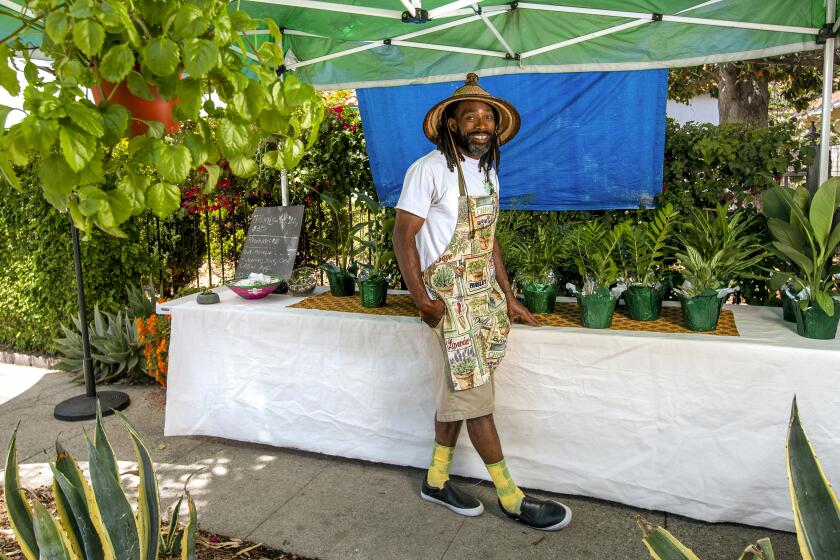
- Share via
- Chefs and influencers flock to the Santa Monica and Hollywood farmers markets, but other lesser-known markets struggle.
- Multiple factors contribute to slower markets, from economic worries to extreme weather. Two in the city could close soon.
- “If I’m the last one, I’ll be the last one,” one regular customer said.
On a Friday afternoon in late October at the Echo Park Farmers Market, activity among multiple vendors in the sparsely populated parking lot just off of Sunset Boulevard is feeling a bit slow. Fall is usually slow, several vendors said, but lately it’s felt almost like each season is slower than the last.
- Share via
“I wish more people were coming,” vendor William Choi said from behind a table of persimmons, apples and grapes.
Choi is a seller for Ventura County-based Cuyama Orchards and has been appearing at the Echo Park Farmers Market for roughly three years. Markets he attends in Orange County and Riverside also feel slower, he said.
Choi and other Echo Park vendors this fall are confronting the potential shuttering of this farmers market, one of two possible market closures in the city along with the Crenshaw Farmers Market. This possibility has sparked a last-ditch fundraising effort by the nonprofit group that runs the markets to save their presence in areas where some residents are food-insecure.
Should Echo Park close, Choi said, he would hate to start from square one elsewhere.

“It’s going to [cause] damage, because I built up here with customer relationships,” he says. “I love this market. If for some reason they close this one, I [will] miss it.”
Farmers markets, their tables gleaming with ripe stone fruit, glossy gourds or ears of corn, have been sprouting up around Southern California for decades. While certain markets such as Santa Monica and Hollywood are considered destinations, featuring some of the most sought-after produce in our state, others are struggling to remain afloat due to diminishing attendance and sales.
The nonprofit Food Access L.A. operates Crenshaw and Echo Park as well as six other farmers markets across the city, including the bustling Hollywood Farmers Market, a favorite of myriad noted L.A. chefs and food influencers. While that Sunday event is far from anemic, other markets overseen by the organization have seen drastic drops in sales — as much as 46% — which can lead to fewer vendors and, in turn, fewer attendees. To help secure a future for these markets, the nonprofit is calling on the community with a membership drive aimed at gaining 300 members who pledge $40 per month.
“Everything is more expensive: insurance, supplies. Everything has just increased and increased,” said Jennifer Grissom, Food Access L.A.’s executive director. “We are also seeing a decline in people shopping at the markets, which is just heartbreaking, so we realized that we were going to need some support to keep going.”
Carts, cash, recycled yogurt containers and making friends with vendors are just some of the ways pro shoppers conquer Los Angeles farmers markets.
Seasonal trends or slow periods are normal, but year over year, Food Access L.A. has seen diminishing sales across many of its markets, which include Crenshaw, Chinatown, Echo Park, Compton, Willowbrook, Atwater Village, Hollywood and Historic South Central. Since July 2022, the Crenshaw Farmers Market has seen a decrease of 46%, while Echo Park’s sales have fallen 21%. Without an infusion of funding, both could close in the next year or two.
There is never one simple reason for a market’s decline.
Farmers markets can be affected by weather not just in terms of attendance but crops, where extreme weather events can hurt output: If a farm’s produce dwindles in a season, it might charge more per item to compensate for the loss, which risks frustrating customers. Food Access L.A.’s formal surveys and informal attendee polling reveal that uncertainty around the economy, especially in an election year, also plays a part in how much customers are willing to spend at the markets, and how often.
More locally, industry-specific factors such as the 2023 Hollywood labor strikes greatly affected restaurants and food sales, and Food Access L.A. saw that trickle-down immediately at its farmers markets. Grissom also acknowledged that farmers markets have become less appealing in a world that values convenience.
The number of farmers markets in the country grew nearly 7% each year from 1994 to 2019, according to a decades-long study by the USDA, to 8,771. But that figure appears to have dropped significantly in the post-pandemic era; today the USDA lists 7,033 farmers markets, with more than 100 in L.A. County.
At the Crenshaw Farmers Market Don Beto, an egg and produce farmer with more than 35 years of experience selling at L.A.’s markets, said he’s noticed a dip in sales across the region over the last few years. He wondered if perhaps there are too many farmers markets and they’ve begun to cannibalize vendors and customers.

Alejandro Sandoval described himself as “a farmers market groupie” and said he’s been shopping at the Echo Park market for three or four years. While he also frequents the Hollywood market, he appreciates the more intimate nature of the smaller Echo Park market — though he categorized it as “very sparse” both in vendors and customers.
“You find camaraderie and community with people,” he said. “If you’re trying to create a collective but there’s no one coming, how do you find a collective with the people that are here?”
Sandoval suggested that programming such as art walks, more live music and a larger variety of stalls could attract like-minded shoppers in the neighborhood, or make it a destination.
Louis Easton, also known as the Plant Mon, has been selling snake plants, succulents and other houseplants at the Crenshaw Farmers Market on and off for over a decade. When the Crenshaw market moved from the Baldwin Hills Crenshaw mall to a small bank-adjacent parking lot in early 2023, multiple vendors noticed a drop-off in shoppers, which Easton credits to a loss of foot traffic from mall shoppers and a lack of visibility.
Says Louis Easton, aka the Plant Mon: “In the Black community, if you say you work like a Jamaican, it means you wear many hats. And that’s me.”
So the Plant Mon has been brainstorming new ways to attract shoppers to the Crenshaw market to boost its appeal, including working with nearby schools, offering gift cards and orchestrating “community crawls.”
“It’s just more marketing and getting the word out and letting people know that we’re here,” he said. “I think we all have to do our part, every last person in here: the farmers, the vendors, the staff, the janitor. Everyone has to know that this is a major benefit, because if it goes away, then the community loses a green spot.”
Katherine Terry has been coming to the Crenshaw Farmers Market for at least 25 years and is a weekly patron. As vendors have decreased in the small Crenshaw parking lot, so have the customers, and so has the selection, a frustration for a vegetarian like Terry. But it doesn’t hinder her attendance.
“We come every week because we like the freshness and we like the community, and recycling dollars in the community,” she said. “To make sure that the farmers market is here for the foreseeable time … we still keep coming, no matter what. If I’m the last one, I’ll be the last one.”

There are examples of markets responding to such challenges and reemerging. The operators of the Topanga Farmers Market, relaunched in March after a nearly six-year hiatus, echoed the scope of the existential struggles: Low vendor and customer turnout was the reason the scenic market went dormant, before Frederika “Freddi” Swanson and her friend and fellow Topanga resident Kate Kimmel revived it.
It’s a different world from 2018: With delivery groceries made easy through multiple apps and websites, requiring just a few clicks on a screen, why leave the house at all? The Topanga market also faced multiple weather and environmental setbacks this year, including a landslide that blocked a crucial entrance to the canyon for months.
“We need a market manager support group,” Swanson said. “It’s nice to know how other people are doing, because we’re working very hard to pull this off week after week. It is comforting to know that we’re all kind of in the same boat.”

The Topanga market operates as a nonprofit and making money was never the chief goal for Kimmel and Swanson. But once they factor in weekly expenses and annual costs such as permits, they find the market barely breaks even — sometimes with only $10 in profit at the end of each week, and never enough to provide a safety net. After a few weeks of closure due to summer heat waves, a sponsorship drive helped keep the market afloat. Looking ahead to 2025, the duo are applying for government grants and other civic funding.
“That could be our saving grace,” Kimmel said. “When we talk about our long-term plans, we think that’s the biggest piece of the puzzle to keep this going.”
Multiple regional farmers markets such as Altadena Farmers Market and the mobile Prosperity Market, which features Black farmers and producers, have launched fundraisers in recent years to aid vendors and offset operating costs and losses.
The mobile farmers market and Black-owned business advocate is raising funds and awareness with a campaign called ‘It’s Bigger Than Us’ and its annual Black Business Scavenger Hunt.
Farmers markets are worth saving, Grissom said, because they offer something that simply not found at “a traditional grocery store, where you don’t know how long those carrots have been out of the ground.”
Freshness of produce in a city dotted with food deserts is the selling point that farmers markets advocates have sought to reemphasize. More than 85% of vendors travel less than 50 miles to sell at farmers markets, according to the national Farmers Market Coalition. Many sell food harvested mere hours before it’s sold — a stark contrast to any fruits or vegetables grown and shipped from across the world.
According to reports by USC and L.A. County, more than 1 million homes and 44% of low-income residents in L.A. County are food-insecure, or lacking access to fresh, healthy food. According to USC’s Institute for Food System Equity, 40% of South L.A. residents live in a food desert. Near the Crenshaw Farmers Market, a handful of corner stores sell produce, but the nearest supermarket is more than a mile away in any direction, and often farther.
“This is a food desert, so it’s really difficult for people here to access healthy foods,” said Melanie Renteria, a G Farms vendor at the Crenshaw Farmers Market. “Then you have all of these junk food areas that are horrible for people, but it’s more affordable, and with the way the economy is right now I think everybody just tries to get whatever’s most affordable.”

On a recent Saturday at the Crenshaw market, Renteria said customers might not realize that many farmers markets nationwide, including those run by Food Access L.A., accept EBT or SNAP as payment.
“They feel like farmers markets have been marketed as something for people who are rich,” Renteria added.
The pandemic and its aftereffects still loom over the prospects for farmers markets everywhere, Grissom said.
“If we have to look for a silver lining or something good that came out of the pandemic, it was that people realized there is a big problem with our food system and getting food to people,” she said. “But what’s sad is that there are actually more food-insecure families now than there were before the pandemic, and people have kind of forgotten.”

Most of Food Access L.A.’s funding arrives via government grants, plus a small stall fee charged to participating vendors; Grissom acknowledged that the organization could not increase the financial burden on their farmers. To reach a “healthy nonprofit budget,” she said, they came up with the membership drive idea.
Though the goal is 300 members who can donate $40 per month, any amount is welcome, be it monthly or a single gift. A $10 monthly donation, for instance, could purchase trash bags and hand sanitizer for the market.
“It’s more than just about food,” Grissom said. “It’s really about the whole wellness of the person and the family and the community.”
More to Read
Eat your way across L.A.
Get our weekly Tasting Notes newsletter for reviews, news and more.
You may occasionally receive promotional content from the Los Angeles Times.















